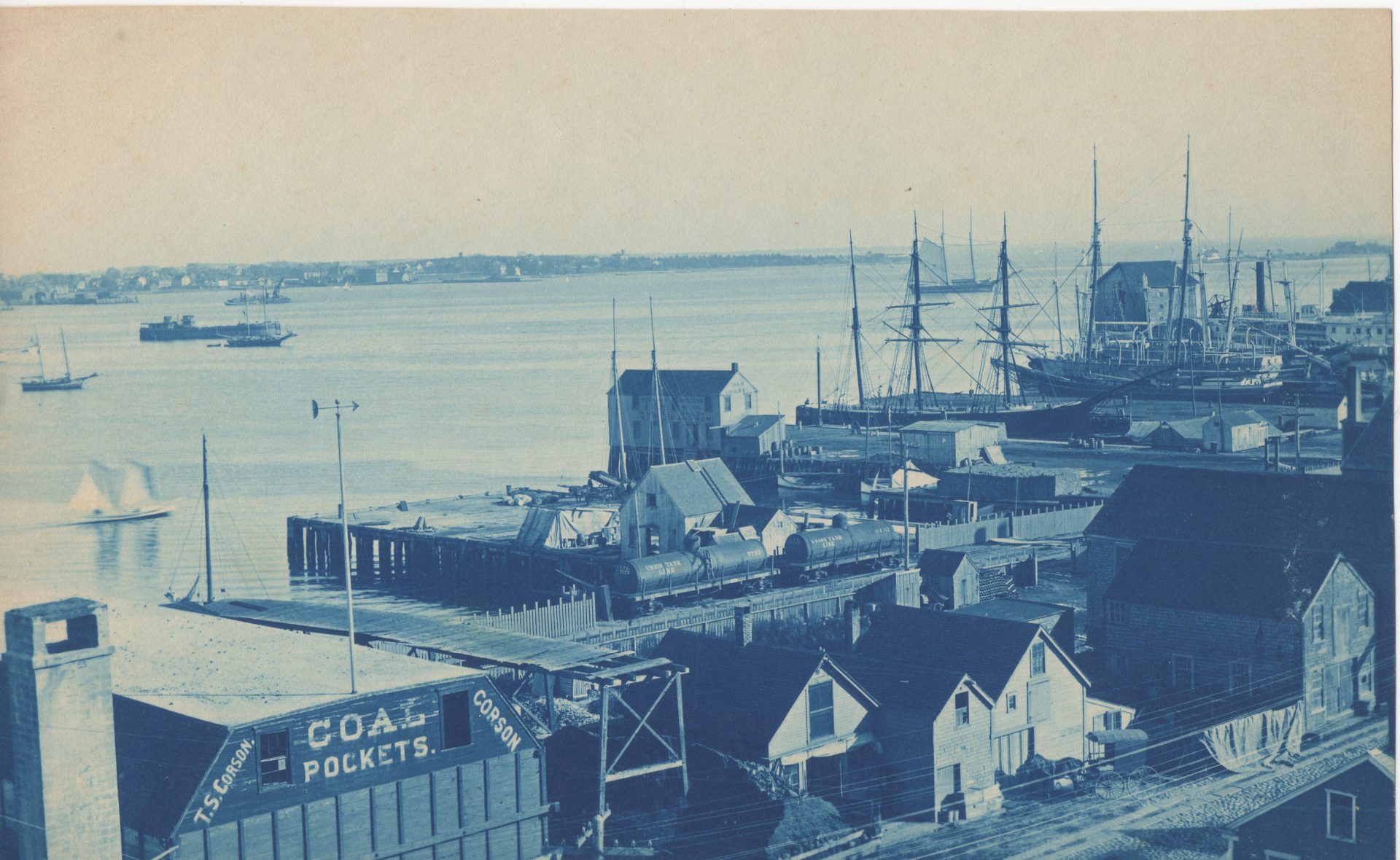The City's Waterfront and Trades
Seafaring and Trade
Seabound destiny
New Bedford's history has been linked with the oceans beyond its fine harbor. Whaling was its premier enterprise but not every ship was a whaler. Even Joseph Rotch, a whaling pioneer, engaged in merchant trade. In December 1773, when the Sons of Liberty dumped tea into Boston Harbor to protest British taxation without representation, the Rotch family's Dartmouth and Beaver, whaleships were part of the tea fleet under charter to the East India Company.
Merchant trade
From the late-eighteenth century on, the Yankee trader carried cargo all over the world. In Maritime History of Massachusetts 1783-1860, Samuel Eliot Morison wrote that ". . . hardly a port of Europe there was. . . where the Yankee trader was not as familiar as the seasons. . ." New Bedford merchants were among them.
The Ann Alexander to the rescue
As Nelson's fleet lay victorious but battered after the Battle of Trafalgar in 1805, the Ann Alexander of New Bedford sailed into view, carrying apples, flour, and lumber — just what hungry sailors and damaged ships needed. The Ann Alexander was sunk by a sperm whale, "On the Line," in the Pacific in 1851, giving rise to Melville's famous remark about the possibility of Moby Dick still being out there.
What they carried in their holds
Merchant ships picked up cargoes in one or more ports and delivered them to others. They carried a variety of goods, including coffee, cotton, flax, fruit, hemp, molasses, pepper, rum, tea, tobacco, and wine.
Where they sailed
From the late 1600s, New England ships were trading with the West Indies and Europe. They helped develop the Caribbean "sugar colonies" by trading food, timber, and European goods for molasses and rum. By the 1830s, Massachusetts merchants entered the lucrative China, India, and spice island trades. New Bedford citizens were major figures in the "China Trade." Household goods and art from Asia began to appear in the mansions of the city's whaling men and merchant traders.
Privateer
During the Revolutionary War and War of 1812, the British blockaded American ports and seized ships on the high seas. Merchant trade and whaling were thwarted. In 1775, when George Washington authorized six private vessels to capture British supply ships, the idea of "privateers" became popular and soon 600 sailed from Massachusetts ports. During the War of 1812, captured vessels were often auctioned in New Bedford, a favorite harbor for running in enemy ships, known as "prizes."
Rebellious stripes in London
The Ship Bedford, owned by New Bedford merchant William Rotch, Jr., sailed for London in 1783, with 487 butts of whale-oil in its hold. (A butt is a barrel-like container, which holds 130 US gallons.) It was the first ship to display the thirteen stripes of the new American nation in a British port.
The New Bedford Wharves
Generically, a wharf is a waterfront construction for mooring vessels for the purposes of safety loading, outfitting, maintenance, and repair.
Usually (as in New Bedford) the wharf was merely a pier built out into the water so as to enable vessels to be moored bow-in and broadside-to.* New York’s 19th-century piers, which were used for the North Atlantic liners in the first half of the 20th century, incorporated large, permanent buildings integral to the construction of the wharf; these were used for offices, showrooms, ticketing, waiting rooms, passenger access, warehousing, and cargo handling. The New Bedford wharves were on a more modest, utilitarian scale, but frequently sheds or buildings were erected on them.
In 19th-century New Bedford the term wharf was also used to characterize a common (but not universal) commercial relationship, signifying a consortium of loosely allied businesses that were affiliated with the various wharves in New Bedford. These consortia typically included at least one managing agent and associated firms of sailmakers, shipsmiths/ whalecraft manufacturers, coopers, sparmakers, pump-and-block makers, outfitters, infitters, and provisioners. For example, the Merrill’s Block building at Merrill’s Wharf, built by Captain Edward Merrill during 1837-47, housed the counting rooms of whaling merchant Jonathan Bourne, the shipsmithing firm of Dean & Driggs, John R. Shurtleff’s sail loft, and so on. At the head of the wharf, just across the railroad tracks on the inland side, were the W.A. Robinson & Company Oil and Candle Works, and the Denison Brothers Eureka Mills, who produced flour and ship’s stores.
Construction details of New Bedford’s early wharves are known only in the most general terms: descriptions are few, and the wharves themselves predate any requirement that the builder file plans, obtain licenses, or comply with building codes or zoning restrictions. Though the city was incorporated in 1847, it was not until 1884 that New Bedford established a Building Board, to review and approve the construction of buildings and wharves in the city. This usually required the submission of plans, some of which survive in the records office for the Southern District of Bristol County at Taunton. It was not until 1893 – when the whaling industry was already in decline and long past the time when whaling wharves were being constructed – that New Bedford set up a municipal system of building permits, of which the records are filed in the City Engineer’s Office at City Hall.
However, thanks to the meticulous record keeping of Benjamin Baker, long-time confidential clerk to Jonathan Bourne & Company, the circumstances of Merrill’s Wharf, which opened in 1847 (and has been known since the 1920s as Homer’s Wharf) are fairly explicit.
* Technically, a wharf and a dock are not the same thing. A dock is an enclosure or pool, usually with a single aperture to allow waterborne entry and egress. Often the aperture had a watertight gate or lock to restrict access, or to regulate water levels against currents or tides. This provided a safe haven from stormy seas, turbulent waters, harbor traffic, and intrusion, and could isolate cargoes for customs purposes and provide security against theft. The most characteristic examples, constructed primarily of dressed stone, are perhaps those in the East End of London, where St. Catherine’s Dock has been converted to a tourist attraction with boutique shops; and at Liverpool, where the Merseyside Maritime Museum has preserved the Albert Dock as an historical monument. The old wharves in the medieval harbor of Hull (Kingston-upon-Hull), which in the 19th century served England’s principal Arctic whaling fleet, are handsomely constructed of brick.
Types of Wharf Construction
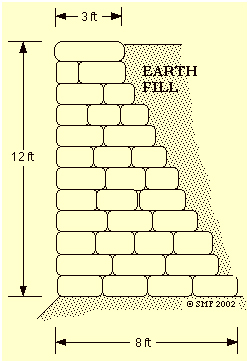
Basic Wharf Wall–Plain Stone with Earth Fill–1873
From a section of a proposed extension of the wharf at Middle and Front Streets, New Bedford. The 1873 plan called for 12 courses of stone, with a base 8 feet deep consisting of four stones, with one stone at the top. A revision of circa the 1880s called for an 8-foot base of three stones. (Land Records, South District, Bristol County of Massachusetts, Plan Book 1, pp 6 and 14.)
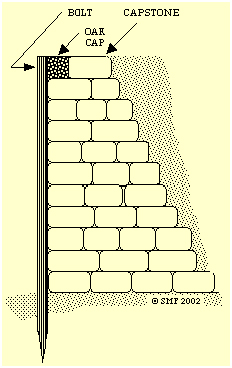
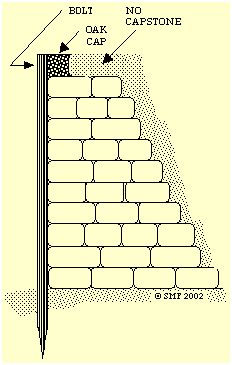
Dressed or Semi-Dressed Stone with Oak Cap and Pilings–1889
The oak fender piles (pilings) are spaced on 18- to 48-inch centers, and driven into the river bed to provide stability and cradle the stone structure. Each piling and the oak cap is coated with hot tar, fastened with bolts, and braced to the stone structure at intervals (below). The oak cap may be flush with the capstone (left) or may supplant a capstone (right). Plans submitted in 1889 call for an oak cap, flush capstone (as on the left), and the face of the pier to be planked over with spruce. Two set of plans dated 1889 and 1894 specify oak caps with no capstone (right), with the addition of oak transverse fenders–oak beams arranged as horizontal struts between the pilings.


Undressed Stone with Cap and Piles–1844
The construction is undressed stone and riprap, held together with a framework of oak, canted out at an unspecified angle, pyramid-like, for strength and stability. The oak cap and oak piles were bolted together with spruce drifts, and the piles overlaid with oak transverse beams (struts) that imparted additional stability and served as fenders. The earth-fill surface was likely covered with gravel, forming a fairly durable roadbed with adequate drainage. (On the commercial shell-fishing piers of Connecticut and Long Island, crushed oyster shells or clam shells, the otherwise useless byproducts of local fisheries, were commonly used for this purpose.) In the 20th century most New Bedford wharves were paved over with macadam or, later, asphalt. The early date of 1844 indicated for this arrangement in the Bristol County records (on what is clearly a much later schematic drawing) implies that it may have been the preferred model for New Bedford wharves when the whaling industry was in its prime. Merrill’s Wharf, completed during 1846-47 and known as Homer’s Wharf since circa 1927, is much changed from its 19th-century state, with little of the original fabric remaining. However, this type of construction appears to be consistent with such evidence as survives of Merrill’s Wharf and some of the adjacent whaling wharves.
Wharves with Other Surfaces
Though these particular records in the Bristol County archives were submitted between 1897 and 1902, they are presumed to represent types in use much earlier in the New Bedford Port District. In whaling days the structure that is here paved in concrete might have been covered with gravel or sea shells, while the all-stone pier is a type known even in early Classical Roman excavations.
MIXED SURFACE WITH WOODEN DECK
The Maxfield Street Wharf embankment in New Bedford was fitted with a wooden extension of this type in 1910 (Records, 9:33). The Philadelphia & Reading Coal & Iron Company Wharf of 1897 was built on wooden pilings and capped over and planked with wood (Records, Vol. 4:35).
WOODEN BRIDGE PIER
An unusual wharf plan was proposed for Nonquitt, Massachusetts, in 1900, consisting of a stone wharf, a series of four minor stone piers, and a larger stone pier, connected by bridges of 4 x 8 inch (10 x 20 cm) wooden cap log beams; these, in turn, were decked over with 2-inch (5 cm) planks. The plan specifies wooden fender piles driven in at the bottom and fastened at the top, presumably using an arrangement of drifts, bolts, and braces similar to those in earlier wharves.
 |
| Aerial view, showing layout of wharf, stone piers, and wooden bridge construction |
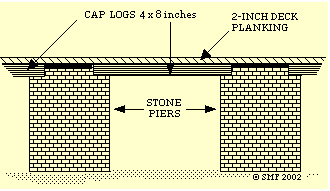 |
| Elevation views, showing the arrangement of cap logs and planking before the addition of wooden piles or pilings (left), and the approximate positioning of the wooden pilings (right). |
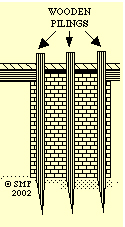 |
